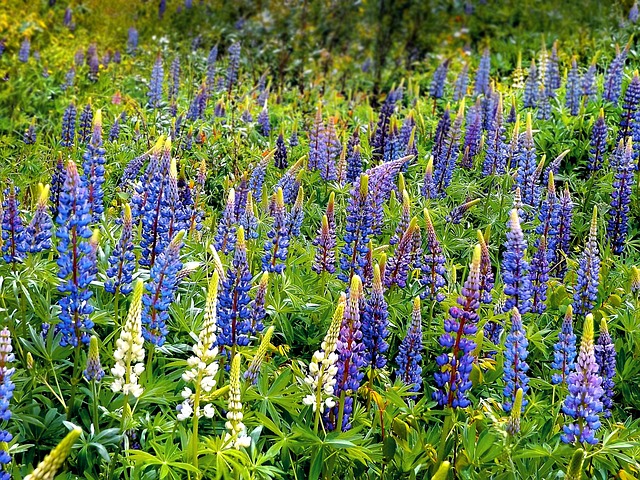  |  |  |   |   |
  |  |  |
Lupines are annual or perennial herbaceous plants (rarely woody), with erect, branched, strongly leafy stems, 1-1.5 m tall (perennial species have several stems). Branches erect, curved or creeping. The root system is peg-shaped, deeply embedded in the soil (1-2m). Rhizobium lupini tubers form on the roots, which accumulate nitrogen from the air. The leaves are usually arranged alternately, compound rays, on long petioles, long, needle-like leaflets.
Inflorescences - a bunch of multi-flowered tops. Flowers arranged alternately. Flower zygomorphic. The flowers of different species have different colors and the flowers can also be striped. The most common flowers are blue.
The fruit is a leathery bean, linear or slightly curved, slightly compressed. The surface is uneven, often with pronounced veins, cream, brown or black. The seeds can be of different shapes and colors, depending on the species. Seeds smooth. Lupins usually bloom in June and early July.
For medicinal purposes, the above-ground part of the plant, inflorescences and seeds, rarely roots are collected. Lilacs are harvested during flowering; inflorescences are collected at the very beginning of flowering; dig the roots as soon as the plant has finished flowering. The plant is dried in a dry, well-ventilated room or in forced dryers at a temperature not exceeding 50C. The drug is stored in a ventilated container, in a dry place. The drug is stored for up to 2 years.
Lupine seeds are harvested as soon as they are ripe. The seeds are dried and stored in a cool, dark place. In this way, they retain their properties for up to 1 year.
Lupine seeds contain protein (42%), vegetable fat (8.6%), alkaloids (lupanine <3.5%, as well as lupinine, luranine, hydroxylupanine, angustifolin), carotene, flavonoids, sugar, starch, fiber, alkali, calcium, nitrogen-free extractive substances, etc. tannins, alkaloids, amino acids (aspartic acid, glutamic acid, etc.), fibers found in the above-ground part of the plant. Lupine leaves contain <2% alkaloid lupanine, flavonoids. The chemical composition of lupine roots is practically unstudied.
Ārstnieciskā nozīme
Ēdamo lupīnu sēklas ir vērtīgs pārtikas produkts. Tās ir bagātas ar viegli uzņemamiem proteīniem, šķiedrvielām, vitamīniem un minerālvielām. Dietologi lupīnas sēklas iesaka lietot slimniekiem ar anoreksiju, sportistiem un cilvēkiem, kuri ilglaicīgi slimo. Ilglaicīga šī produkta lietošana sakārto gremošanas trakta darbību, pastiprina izturību pret infekcijas slimībām un uzlabo sirds- asinsvadu sistēmas stāvokli.
Lupīnas ir augi, kurus oficiālā medicīna neizmanto, taču tā kā augā ir daudz vērtīgu vielu, tad arī tām piemīt savas ārstnieciskās īpašības. Lupīnās esošie alkaloīdi ir spējīgi vigli tonizēt cilvēka organismu, stimulēt tā sirdsdarbību, iedarboties antiseptiski un spazmolītiski. Miecvielas iedarbojas savelkoši, kas ļauj lupīnas izmantot ādas slimību ārstēšanā, ja tās pavada iekaisuma procesi un sastrutojumi.
Zinātniekiem ir izdevies pierādīt, ka lupīnu sēklas ir spējīgas mazināt holesterīna daudzumu asinīs, kā arī mazināt risku veidoties cukura diabētam. Lupīnu dzeltenajās sēklās ir īpaša olbaltumviela- glikoproteīns, kurš spēj aizvietot insulīnu. Pilnīgi iespējams, ka šī auga īpašības, nākotnē, tiks izmantotas otrā tipa diabēta ārstēšanai.
Daudzus gadsimtus lupīnas tiek izmantotas Dienvidu un Ziemeļu Amerikā, kā atsāpinošs, pretmikrobu, pretiekaisuma un tonizējošs līdzeklis. Tautas zintnieki lieto lupīnas lakstus, lai gatavotu dažādus ūdens nostādinājumus un novārījumus, spirta ekstraktus, kurus lieto ārīgi, lai ārstētu ādas slimības, čūlas, pampumus, pūtītes uz sejas un ķermeņa. Sasmalcināta auga virszemes daļa putriņā, aplikāciju veidā ir spējīga mazināt sāpes, sēžas nerva un locītavu iekaisuma gadījumā. Lupīnas novārījums ir spējīgs dziedēt sastrutojušas brūces, to lieto arī gangrēnas un ādas plīsumu gadījumā. Lupīnu sēklu milti spēj ārstēt mitrās čūlas uz ķermeņa.
Ir zināmi arī gadījumi, kad lupīnu eļļu lieto, lai ārstētu aknas, liesu un žults pūsli.
